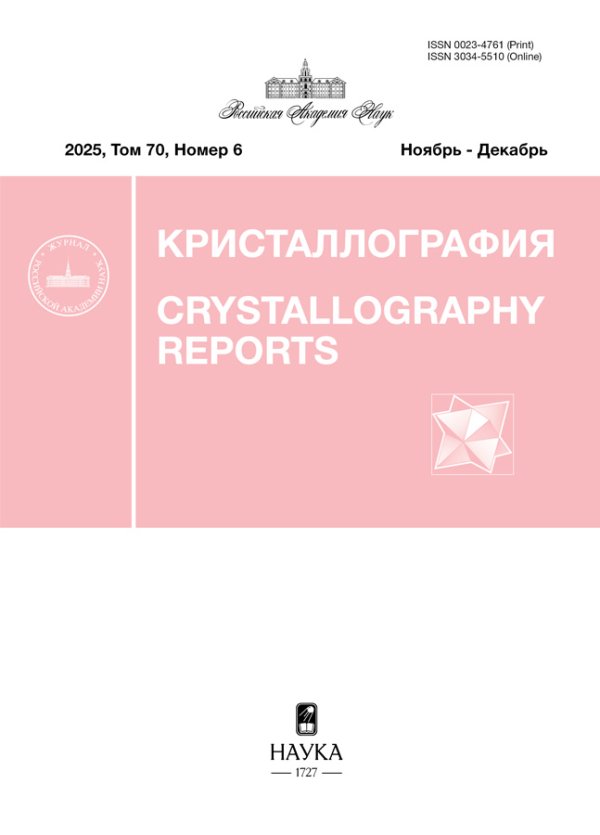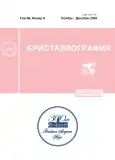Предварительное рентгеновское исследование кристаллов, полученных при сокристаллизации гипоксантин-гуанинфосфорибозилтрансферазы из Escherichia coli и производных пиразин-2-карбоксамида
- Авторы: Абрамчик Ю.А.1,2, Заяц Е.А.1, Тимофеев В.И.2,3, Шевцов М.Б.4, Костромина М.А.1, Фатеев И.В.1, Юровская Д.О.1, Каранов А.А.1, Константинова И.Д.1, Куранова И.П.2,3, Есипов Р.С.1
-
Учреждения:
- Институт биоорганической химии РАН
- Институт кристаллографии им. А.В. Шубникова ФНИЦ “Кристаллография и фотоника” РАН
- Национальный исследовательский центр “Курчатовский институт”
- Московский физико-технический институт
- Выпуск: Том 68, № 6 (2023)
- Страницы: 854-858
- Раздел: СТРУКТУРА МАКРОМОЛЕКУЛЯРНЫХ СОЕДИНЕНИЙ
- URL: https://journals.rcsi.science/0023-4761/article/view/231798
- DOI: https://doi.org/10.31857/S002347612360012X
- EDN: https://elibrary.ru/ZZVSQF
- ID: 231798
Цитировать
Полный текст
Аннотация
Создан высокоэффективный штамм-продуцент Escherichia coli C3030/pET23d+-EcHGPRT, позволяющий получать рекомбинантную гипоксантин-гуанинфосфорибозилтрансферазу из E. coli (EcHGPRT) в растворимой форме. Разработана методика выделения и очистки рекомбинантного белка. Определена удельная активность в отношении природного субстрата и производных пиразин-2-карбоксамида. Методом встречной диффузии в капилляре выращены кристаллы комплексов EcHGPRT с 3-гидроксипиразин-2-карбоксамидом (T-1105) и с 6-фтор-3-гидроксипиразин-2-карбоксамидом (T-705), пригодные для рентгеноструктурного исследования. Дифракционные наборы до разрешения соответственно 2.4 и 2.5 Å собраны на синхротроне ESRF (Франция, станция ID23-1) при температуре 100 K. Кристаллы относятся к пр. гр. P3(1)21, в независимой части ячейки содержатся две молекулы фермента.
Об авторах
Ю. А. Абрамчик
Институт биоорганической химии РАН; Институт кристаллографии им. А.В. Шубникова ФНИЦ “Кристаллография и фотоника” РАН
Email: ugama@yandex.ru
Россия, Москва; Россия, Москва
Е. А. Заяц
Институт биоорганической химии РАН
Email: ugama@yandex.ru
Россия, Москва
В. И. Тимофеев
Институт кристаллографии им. А.В. Шубникова ФНИЦ “Кристаллография и фотоника” РАН; Национальный исследовательский центр “Курчатовский институт”
Email: ugama@yandex.ru
Россия, Москва; Россия, Москва
М. Б. Шевцов
Московский физико-технический институт
Email: ugama@yandex.ru
Россия, Долгопрудный
М. А. Костромина
Институт биоорганической химии РАН
Email: ugama@yandex.ru
Россия, Москва
И. В. Фатеев
Институт биоорганической химии РАН
Email: ugama@yandex.ru
Россия, Москва
Д. О. Юровская
Институт биоорганической химии РАН
Email: ugama@yandex.ru
Россия, Москва
А. А. Каранов
Институт биоорганической химии РАН
Email: ugama@yandex.ru
Россия, Москва
И. Д. Константинова
Институт биоорганической химии РАН
Email: ugama@yandex.ru
Россия, Москва
И. П. Куранова
Институт кристаллографии им. А.В. Шубникова ФНИЦ “Кристаллография и фотоника” РАН; Национальный исследовательский центр “Курчатовский институт”
Email: ugama@yandex.ru
Россия, Москва; Россия, Москва
Р. С. Есипов
Институт биоорганической химии РАН
Автор, ответственный за переписку.
Email: ugama@yandex.ru
Россия, Москва
Список литературы
- Hucke F.I.L., Bestehorn-Willmann M., Bassetto M. et al. // Virus Genes. 2022. V. 58 (3). P. 188. https://doi.org/10.1007/s11262-022-01892-x
- De Vleeschauwer A.R., Lefebvre D.J., Willems T. et al. // Transbound. Emerg. Dis. 2016. V. 63 (2). P. e205. https://doi.org/10.1111/tbed.12255
- Hayden F.G., Shindo N. // Curr. Opin. Infect. Dis. 2019. V. 32 (2). P. 176. https://doi.org/10.1097/QCO.0000000000000532
- Delang L., Abdelnabi R., Neyts J. // Antiviral Res. 2018. V. 153. P. 85. https://doi.org/10.1016/j.antiviral.2018.03.003
- De Clercq E., Li G. // Clin. Microbiol. Rev. 2016. V. 29 (3). P. 695. https://doi.org/10.1128/CMR.00102-15
- Furuta Y., Takahashi K., Shiraki K. et al. // Antiviral Res. 2009. V. 82 (3). P. 95. https://doi.org/10.1016/j.antiviral.2009.02.198
- Furuta Y., Komeno T., Nakamura T. // Proc. Jpn. Acad. B. Phys. Biol. Sci. 2017. V. 93 (7). P. 449. https://doi.org/10.2183/pjab.93.027
- Lu J.W., Chen Y.C., Huang C.K. et al. // Antiviral Res. 2021. V. 195 P. 105188. https://doi.org/10.1016/j.antiviral.2021.105188
- Furuta Y., Takahashi K., Fukuda Y. et al. // Antimicrob. Agents Chemother. 2002. V. 46 (4). P. 977. https://doi.org/10.1128/AAC.46.4.977-981.2002
- Konstantinova I.D., Andronova V.L., Fateev I.V., Esipov R.S. // Acta Naturae. 2022. V. 14 (2). P. 16. https://doi.org/10.32607/actanaturae.11652
- Negru P.A., Radu A.F., Vesa C.M. et al. // Biomed. Pharmacother. 2022. V. 147. P. 112700. https://doi.org/10.1016/j.biopha.2022.112700
- Hung D.T., Ghula S., Aziz J.M.A. et al. // Int. J. Infect. Dis. 2022. V. 120. P. 217. https://doi.org/10.1016/j.ijid.2022.04.035
- Garcia-Lledo A., Gomez-Pavon J., Gonzalez Del Castillo J. et al. // Rev. Esp. Quimioter. 2022. V. 35 (2). P. 115. https://doi.org/10.37201/req/158.2021
- Naesens L., Guddat L.W., Keough D.T. et al. // Mol. Pharmacol. 2013. V. 84 (4). P. 615. https://doi.org/10.1124/mol.113.087247
- Sangawa H., Komeno T., Nishikawa H. et al. // Antimicrob. Agents Chemother. 2013. V. 57 (11). P. 5202. https://doi.org/10.1128/AAC.00649-13
- Shannon A., Selisko B., Le N.T. et al. // Nat. Commun. 2020. V. 11 (1). P. 4682. https://doi.org/10.1038/s41467-020-18463-z
- Eads J.C., Scapin G., Xu Y. et al. // Cell. 1994. V. 78 (2). V. 325. https://doi.org/10.1016/0092-8674(94)90301-8
- Schumacher M.A., Carter D., Roos D.S. et al. // Nat. Struct. Biol. 1996. V. 3 (10). P. 881. https://doi.org/10.1038/nsb1096-881
- Guddat L.W., Vos S., Martin J.L. et al. // Protein Sci. 2002. V. 11 (7). P. 1626. https://doi.org/10.1110/ps.0201002
- Shi W., Li C.M., Tyler P.C. et al. // Biochemistry. 1999. V. 38 (31). P. 9872. https://doi.org/10.1021/bi990664p
- Focia P.J., Craig 3rd S.P., Nieves-Alicea R. et al. // Biochemistry. 1998. V. 37 (43). P. 15066. https://doi.org/10.1021/bi981052s
- Shi W., Munagala N.R., Wang C.C. et al. // Biochemistry. 2000. V. 39 (23). P. 6781. https://doi.org/10.1021/bi000128t
- Monzani P.S., Trapani S., Thiemann O.H., Oliva G. // BMC Struct. Biol. 2007. V. 7 (59). https://doi.org/10.1186/1472-6807-7-59
- Takahashi S., Tsurumura T., Aritake K. et al. // Acta Cryst. F. 2010. V. 66 (7). P. 846. https://doi.org/10.1107/S1744309110020828
- Battye T.G., Kontogiannis L., Johnson O. et al. // Acta Cryst. D. 2011. V. 67 (4). P. 271. https://doi.org/10.1107/S0907444910048675
- Huchting J., Winkler M., Nasser H., Meier C. // ChemMedChem. 2017. V. 12 (9). P. 652. https://doi.org/10.1002/cmdc.201700116
Дополнительные файлы












